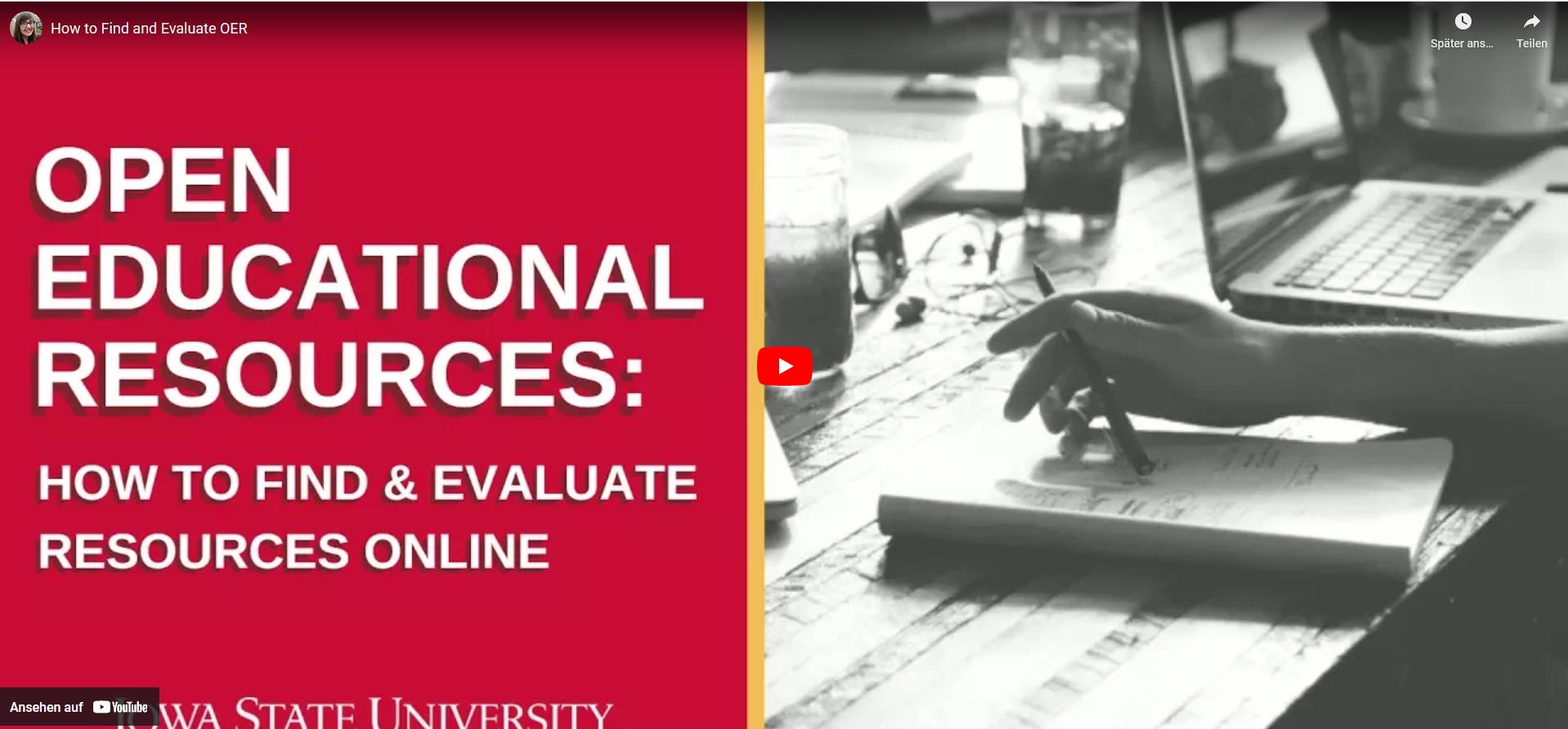Search and find OER
Searching for materials on the Internet can lead to frustration, as the amount of information appears unstructured at first glance. However, in order to take advantage of the large variety of materials available, it is advisable to proceed in a structured manner.
The production and use of Open Educational Resources (OER) are central to the open knowledge community. An overview of this can be found in Open Educational Resources: Introduction. The guide How-to guide: Creating OER offers practical hints for creating ethical, high-quality OER. At the same time, the guide How-to guide: Using OER provides insights into the selection and integration of existing OER, focussing on licensing, timeliness and quality. This information supports the creation and use of freely accessible educational material, promotes the transfer of knowledge and benefits teachers and learners alike.
Internet research
In the university context, for example, a three-step approach suggests itself:
- Analysis of needs: First, you should clarify your needs and define clear search criteria. What exactly do you need for your teaching purposes? What topics, formats, or quality criteria are important?
- Find OER (in unit repositories or repositories): You can then search specifically for OER. To do this, use referatoriums or repositories that are specifically designed for OER content. These platforms offer structured and well-categorized collections of educational materials.
- Evaluate and select OER: Once you have found potential materials, evaluate them carefully. Pay attention to the quality, timeliness, and relevance of the resources. Make sure they meet your educational goals and meet the needs of your learners.
Analysis of needs and defining criteria
Before you begin your search for OER, it is critical to clearly define your needs for using OER. Analyzing your existing materials will allow you to identify which resources have potential for improvement and how OER can be usefully used to supplement them.
Although this step is often taken for granted and is often the starting point for OER searches, due to the volume and variety of OER, it is highly advisable to systematically incorporate the needs analysis into the entire process and establish clear search criteria that meet your individual needs.
Find OER
Technically, there are two types of platforms where educational materials can be searched and found:
Repositories (repositories): These are databases where educational resources are stored and archived. An example might be a library's publication server.
Referatoriums (Referatories): Referatories contain metadata and links pointing to educational materials. This enables searches for explicit OER materials, especially through the machine-readable tagging of CC licenses.
In any case, for a targeted search for OER, it is important to know and use the filter and search functions on the respective platforms. This is crucial because the search results on many platforms, unless they exclusively host free educational materials, can be restricted based on licensing and usage rights criteria. However, it is advisable not to rely solely on these search results, but to check the license indicated directly on the materials. Below are examples of some platforms where you can find open educational materials.
- Google Search
- Repositories like ZOERR (material for higher education)
- Libraries
- eTwinning and School Education Gateway (material for schools and teachers)
- On the Una Europa website you will find a curated list of links that you can use to find OER material.
- In Norway Canvas and especially Dembra and 22juli-senteret are two free platforms for teaching materials, both related to topics such as democracy, antiracism, plurality and critical thinking.
Hint: In Google Image Search, you can select Creative Commons licences in the search filters. However, it is advisable to ensure that the licence has been specified correctly in each individual case.
Evaluate and select OER
It is advisable to check these materials for the credibility of the source in order to be able to use the materials without legal concerns. In doing so, you should be aware that while you cannot expect 100 percent certainty, you can make a careful selection similar to finding good scientific sources. Some indications of credible sources might be:
- Involvement of reputable organizations: Materials produced by reputable educational institutions, universities, or well-known educational organizations are often reliable and credible.
- Clean citation: check that the materials are properly cited and refer to reliable sources. This shows that the authors acknowledge the work of others and are reputable.
- Source and licensing information: Make sure materials clearly state the source and license used. This will allow you to understand the legal terms and ensure that you are using the materials correctly.
- Didactic layout: pay attention to the presentation and layout of the materials. Well-designed and structured content is often more reliable and user-friendly.
Further information on how to find and evaluate OER
On Open Educational Resources (OER) toolkit | Una Europa you can find more information on the criteria. The Iowa State University has also created a series of videos and collections that provide all the important information step by step.
 Open Educational Resources: How to Find and Evaluate OER by Abbey Elder via YouTube is licensed under a Creative Commons - BY 4.0 International (CC BY 4.0).
Open Educational Resources: How to Find and Evaluate OER by Abbey Elder via YouTube is licensed under a Creative Commons - BY 4.0 International (CC BY 4.0).
— Note: This guide was created in collaboration with the Project ValiDE. The materials were developed by ValiDE and transferred to the ZenDi Wiki by TEgoDi.
